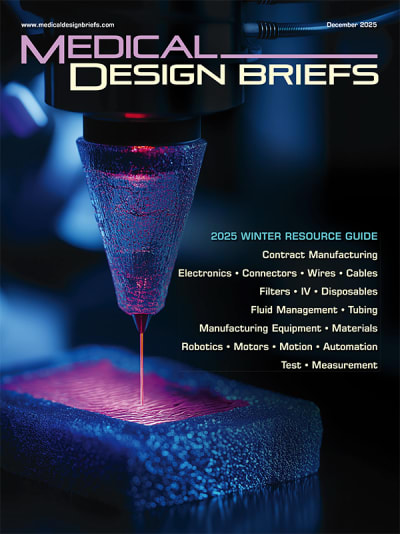Lost your Username or your Password ?
Top Stories
INSIDER: Medical
Brain Implant Enables Safer Drug Delivery
INSIDER: Sensors/Data Acquisition
Pill-Sized Bioprinter Can Be Guided to Disease Site
Products: Wearables
INSIDER: Medical
Wireless Patch Enables Early Cancer Detection
INSIDER: Medical
Boston Scientific to Acquire Nalu Medical, Inc.
Features: Wearables
The Promise and Challenge of On-Body Biosensors: A Perspective on Clinical...
Ask the Expert
Ralph Bright on the Power of Power Cords

Understanding power system components and how to connect them correctly is critical to meeting regulatory requirements and designing successful electrical products for worldwide markets. Interpower’s Ralph Bright defines these requirements and explains how to know which cord to select for your application.
Inside Story
Inside Story: Trends in Packaging and Sterilization

Eurofins Medical Device Testing (MDT) provides a full scope of testing services. In this interview, Eurofins’ experts, Sunny Modi, PhD, Director of Package Testing; and Elizabeth Sydnor, Director of Microbiology; answer common questions on medical device packaging and sterilization.
Webcasts
 Podcasts: Medical
Podcasts: Medical
Developing Sustainable Drug-Delivery Devices
 Podcasts: Medical
Podcasts: Medical
Smarter Pathways for Precision Drug Delivery in Cancer Care
 On-Demand Webinars: Connectivity
On-Demand Webinars: Connectivity
Understanding Testing and Compliance Requirements for Wireless Medical Devices
 Podcasts: AR/AI
Podcasts: AR/AI
Personalized Medicine and Drug Delivery
 Podcasts: Medical
Podcasts: Medical
Material Science Innovations for Medical Devices
 Podcasts: AR/AI
Podcasts: AR/AI
Automation, Robotics, and AI Integration in Medical Manufacturing

